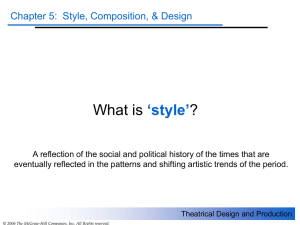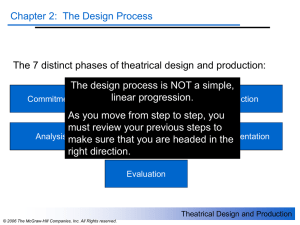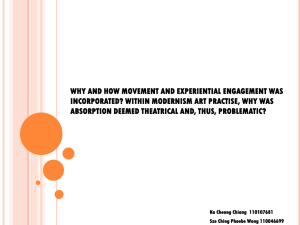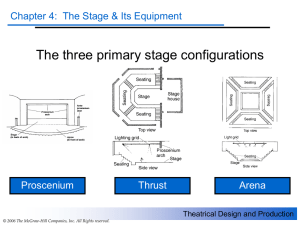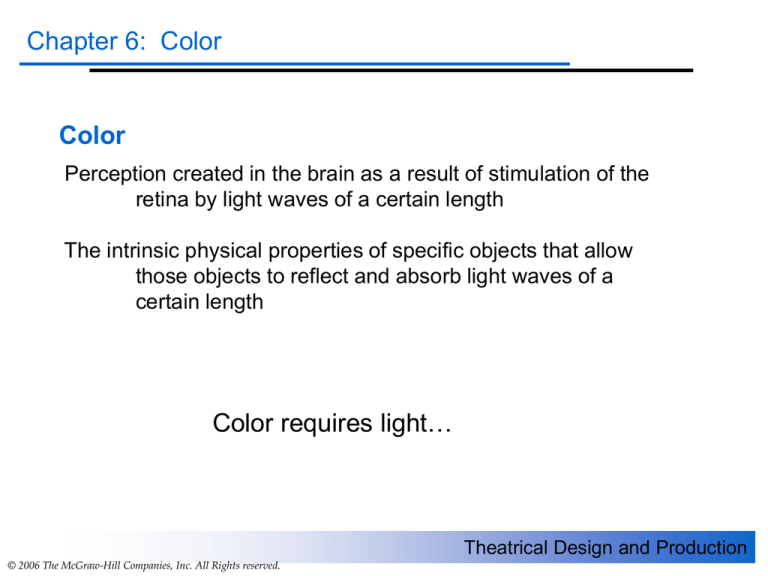
Chapter 6: Color
Color
Perception created in the brain as a result of stimulation of the
retina by light waves of a certain length
The intrinsic physical properties of specific objects that allow
those objects to reflect and absorb light waves of a
certain length
Color requires light…
Theatrical Design and Production
© 2006 The McGraw-Hill Companies, Inc. All Rights reserved.
Chapter 6: Color
1022 Hz
1021 Hz
1020 Hz
1019 Hz
1018 HZ
1017 Hz
1016 Hz
1015 Hz
1014 Hz
1013 Hz
1012 Hz
1011 Hz
1010 Hz
109 Hz
108 Hz
107 Hz
106 Hz
105 Hz
Cosmic rays
Gamma rays
X-rays
Ultraviolet
Visible light
Infrared
Light
portion of the spectrum of
electromagnetic radiation that is
visible to the human eye
Radar
Television
Commercial radio
Theatrical Design and Production
© 2006 The McGraw-Hill Companies, Inc. All Rights reserved.
Chapter 6: Color
Light - portion of the spectrum of electromagnetic radiation that is visible to
the human eye
Frequency range: approx. 750 nanometers to 400 nanometers
(Nanometer = 1 billionth of a meter)
Theatrical Design and Production
© 2006 The McGraw-Hill Companies, Inc. All Rights reserved.
Chapter 6: Color
Hue: The quality that differentiates
one color from another (the name
of the color)
Color Terminology
Saturation: (Chroma)
The amount or % of a particular
hue in a color mixture
(Higher saturation = more hue)
hue
Value: Relative lightness or
darkness of a color
tone
Tint: A color with a high value –
usually achieved by mixing white
with a hue
Shade: A color with a low value
– usually achieved by mixing
black with a hue
shade
tint
white
gray
black
Tone: Color of middle value –
usually achieved by mixing black
and white with a hue
Theatrical Design and Production
© 2006 The McGraw-Hill Companies, Inc. All Rights reserved.
Chapter 6: Color
How does the human eye see color?
An electrochemical reaction interprets the
simulation received when light is emitted by
or reflected from an object.
The light receptor nerves:
Rods – Sensitive to faint light
Cones – Sensitive to bright light (red, blue, green)
Theatrical Design and Production
© 2006 The McGraw-Hill Companies, Inc. All Rights reserved.
Chapter 6: Color
Sunlight contains all
electromagnetic
wavelengths of the
visible spectrum
Reflected blue and
green light is
received by the eye
in the cones which
then send signals to
the brain to be
interpreted as
turquoise
Light strikes a blue-green paint
chip and the wavelengths that
respond to that color are
reflected – all other wavelengths
are absorbed.
Theatrical Design and Production
© 2006 The McGraw-Hill Companies, Inc. All Rights reserved.
Chapter 6: Color
Color Mixing – Primary Colors
Hues that cannot be derived or blended from any other hues.
light
pigment
Theatrical Design and Production
© 2006 The McGraw-Hill Companies, Inc. All Rights reserved.
Chapter 6: Color
Color Mixing – Secondary Colors
light
pigment
Hues that result from mixing two primary colors.
Theatrical Design and Production
© 2006 The McGraw-Hill Companies, Inc. All Rights reserved.
Chapter 6: Color
Color Mixing – Complementary Colors
light
pigment
Any two hues that, when combined yield white in light or black in pigment.
Theatrical Design and Production
© 2006 The McGraw-Hill Companies, Inc. All Rights reserved.
Chapter 6: Color
Color Mixing – Theory vs. Practice
Theory…
Complimentary hues = 1 primary hue + 1 secondary hue
Secondary hue = 1 primary hue + 1 primary hue
Complimentary = All 3 primary colors = Black (pigment)
– Absence of light – not reflected color – Black –
Practice…
No pure pigments, so no pure black
Theatrical Design and Production
© 2006 The McGraw-Hill Companies, Inc. All Rights reserved.
Chapter 6: Color
Color and Light
When white light passes through a filter, part of the spectrum is absorbed…
Subtractive Color Mixing…
Color filters allow only their own hue to pass through
Saturation changes how much is absorbed/transmitted
Theatrical Design and Production
© 2006 The McGraw-Hill Companies, Inc. All Rights reserved.
Chapter 6: Color
Color and Light
When white light passes through a filter, part of the spectrum is absorbed…
Additive Color Mixing…
Eye adds together several
individual hues.
Hue is NOT created!!!
Cones in eye are stimulated
and brain interprets the mix as
a particular hue
Tones, tints, and shades are
determined by level of
stimulation to the cones
Theatrical Design and Production
© 2006 The McGraw-Hill Companies, Inc. All Rights reserved.
Chapter 6: Color
Color and Paint
Color mixing in paint = subtractive process
Selective absorption characteristics of
individual hues in a paint mix cause a
reduction in saturation in the resultant hue…
How ‘bright’ or ‘rich’ your orange is depends on
the saturation of the red and yellow mixed to
create it…
Theatrical Design and Production
© 2006 The McGraw-Hill Companies, Inc. All Rights reserved.
Chapter 6: Color
The Integrated Color Wheel
Places light and
pigment on the same
wheel
Renames the primary
colors of light
Reflects a more ‘true’
relationship between
various hues in
pigment and light
= Light
= Pigment
Theatrical Design and Production
© 2006 The McGraw-Hill Companies, Inc. All Rights reserved.
Chapter 6: Color
Hue relationship chart…
Values of the colors on the outside
columns correspond with the
values of the adjacent gray blocks
on the center gray-scale column
Theatrical Design and Production
© 2006 The McGraw-Hill Companies, Inc. All Rights reserved.
Chapter 6: Color
Complementary hue-tone
relationships…
The value of a specific hue changes
as white or black is added.
The values of the resultant tints and
shades on the outside columns
correspond with the values of the
adjacent gray blocks of the central
gray scale.
Theatrical Design and Production
© 2006 The McGraw-Hill Companies, Inc. All Rights reserved.
Chapter 6: Color
A word of warning…
All discussion of color theory assumes that hues are 100% pure
and saturate.
In practice, they NEVER are… unless considerable expense and
effort is expended
End results often vary from theory –
Practice is always dependent on other elements that theory
cannot predict or assume
Theatrical Design and Production
© 2006 The McGraw-Hill Companies, Inc. All Rights reserved.
Chapter 6: Color
Color and Meaning: Common interpretations (not always ‘correct’)
Yellow:
stimulating, cheerful, exciting, joyful, serene, unpleasant, aggressive, hostile
Orange:
warm, happy, merry, exciting, stimulating, hot, disturbed, distressed, unpleasant
Red:
happy, affectionate, loving, exciting, striking, active, intense, defiant, powerful,
masterful, strong, aggressive, hostile
Green:
youthful, fresh, leisurely, secure, calm, peaceful, emotionally controlled, ill
Blue:
pleasant, cool, secure, comfortable, tender, soothing, social, dignified, sad, strong,
full, great
Violet:
dignified, stately, vigorous, disagreeable, sad, despondent, melancholy, unhappy,
depressing
Black:
sad, melancholy, vague, unhappy, dignified, stately, strong, powerful, hostile,
distressed, fearful, old
White:
pure, tender, soothing, solemn, empty
Brown:
secure, comfortable, full, sad, disagreeable
Theatrical Design and Production
© 2006 The McGraw-Hill Companies, Inc. All Rights reserved.
Chapter 6: Color
Practical Use - Pigment
Hues of medium saturation and value: background rather than
focus
Proximity impacts spectators: strong contrast = greater tension
Accent colors: small touches of contrasting color used by scenic
and costume designers to enhance visual look
Color selection impacts viewer by color meaning as well as
visual translation!!!
Theatrical Design and Production
© 2006 The McGraw-Hill Companies, Inc. All Rights reserved.
Chapter 6: Color
Practical Use - Light
Typically avoid heavy saturation: hard on skin and clothing!
Seek to enhance rather than distract: brain stimulation with additive color
Serve to enhance color palette of scenic and costume designers
Sense of environment
achieved by ‘mixed’ white light
(can go slightly warm or
slightly cool…)
Focus and understanding of
environment also draws on
color meaning with light
Theatrical Design and Production
© 2006 The McGraw-Hill Companies, Inc. All Rights reserved.
Chapter 6: Color
Color Analysis of Terra Nova
Scenic Design
Theatrical Design and Production
© 2006 The McGraw-Hill Companies, Inc. All Rights reserved.
Chapter 6: Color
Color Analysis of Terra Nova
Scenic Design
Theatrical Design and Production
© 2006 The McGraw-Hill Companies, Inc. All Rights reserved.
Chapter 6: Color
Color Analysis of Terra Nova
Costume Design
Theatrical Design and Production
© 2006 The McGraw-Hill Companies, Inc. All Rights reserved.
Chapter 6: Color
Color Analysis of Terra Nova
Lighting Design
Color Key for lighting design
Arrows indicate direction from
which the light is traveling toward
the stage.
The horizontal flags on the arrows
at the upper part of the illustration
indicated that those lights are
coming from above, rather than
behind, the actors
Theatrical Design and Production
© 2006 The McGraw-Hill Companies, Inc. All Rights reserved.
Chapter 6: Color
Color Analysis of Terra Nova
Lighting Design
Numbers indicate Roscolux gel colors – Notice a ‘cooler’ look in the image
Theatrical Design and Production
© 2006 The McGraw-Hill Companies, Inc. All Rights reserved.
Chapter 6: Color
Color Analysis of Terra Nova
Lighting Design
Numbers indicate Roscolux gel colors –
Spotlight is also used in this image
Theatrical Design and Production
© 2006 The McGraw-Hill Companies, Inc. All Rights reserved.
Chapter 6: Color
Color Analysis of Terra Nova
Lighting Design
Numbers indicate Roscolux gel colors – England vs. Antarctica
Theatrical Design and Production
© 2006 The McGraw-Hill Companies, Inc. All Rights reserved.
Chapter 6: Color
Color Analysis of Terra Nova
Lighting Design
Numbers indicate Roscolux gel colors – ‘warmer’ look evident in this scene
Theatrical Design and Production
© 2006 The McGraw-Hill Companies, Inc. All Rights reserved.
Chapter 6: Color
Color Analysis of Cabaret
Scenic Design
Theatrical Design and Production
© 2006 The McGraw-Hill Companies, Inc. All Rights reserved.
Chapter 6: Color
Color Analysis of Cabaret
Scenic Design
Theatrical Design and Production
© 2006 The McGraw-Hill Companies, Inc. All Rights reserved.
Chapter 6: Color
Color Analysis of Cabaret
Costume Design
Theatrical Design and Production
© 2006 The McGraw-Hill Companies, Inc. All Rights reserved.
Chapter 6: Color
Color Analysis of Cabaret
Costume Design
Theatrical Design and Production
© 2006 The McGraw-Hill Companies, Inc. All Rights reserved.
Chapter 6: Color
Color Analysis of Cabaret
Costume Design
Theatrical Design and Production
© 2006 The McGraw-Hill Companies, Inc. All Rights reserved.
Chapter 6: Color
Color Analysis of Cabaret
Lighting Design
3 Primary Considerations:
1) Full-spectrum of colors in
costume design & set
2) Heavy, smoke-filled,
sensuous atmosphere
3) Need for a ‘lighter’ more
realistic atmosphere
outside the cabaret
Theatrical Design and Production
© 2006 The McGraw-Hill Companies, Inc. All Rights reserved.

